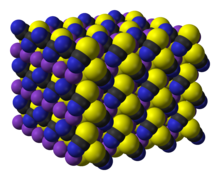
| |

| |
| Names | |
|---|---|
| Other names
Potassium sulfocyanate
Potassium isothiocyanate (tautomeric form) Potassium thiocyanide Potassium rhodanide | |
| Identifiers | |
3D model (JSmol)
|
|
| 3594799 | |
| ChEBI | |
| ChemSpider | |
| ECHA InfoCard | 100.005.792 |
| EC Number |
|
| 21362 | |
PubChem CID
|
|
| RTECS number |
|
| UNII | |
CompTox Dashboard (EPA)
|
|
| |
| |
| Properties | |
| KSCN | |
| Molar mass | 97.181 g mol−1 |
| Appearance | Colorless deliquescent crystals |
| Odor | Odorless |
| Density | 1.886 g/cm3 |
| Melting point | 173.2 °C (343.8 °F; 446.3 K) |
| Boiling point | 500 °C (932 °F; 773 K) (decomposes) |
| 177 g/100 mL (0 °C) 217 g/100 mL (20 °C) | |
| Solubility | acetone: 21.0 g/100 mL ethanol: soluble |
| −48.0·10−6 cm3/mol | |
| Hazards | |
| GHS labelling: | |
 
| |
| Warning | |
| H302, H312, H318, H319, H332, H412 | |
| P261, P264, P270, P271, P273, P280, P301+P312, P302+P352, P304+P312, P304+P340, P305+P351+P338, P310, P312, P322, P330, P337+P313, P363, P501 | |
| NFPA 704 (fire diamond) | |
| Lethal dose or concentration (LD, LC): | |
LD50 (median dose)
|
854 mg/kg (oral, rat)[1] |
| Safety data sheet (SDS) | ICSC 1088 |
| Related compounds | |
Other anions
|
Potassium cyanate Potassium cyanide |
Other cations
|
Sodium thiocyanate Ammonium thiocyanate |
Except where otherwise noted, data are given for materials in their standard state (at 25 °C [77 °F], 100 kPa).
| |
Potassium thiocyanate is the chemical compound with the molecular formula KSCN. It is an important salt of the thiocyanate anion, one of the pseudohalides. The compound has a low melting point relative to most other inorganic salts.
Uses[edit]
Chemical synthesis[edit]
Aqueous KSCN reacts almost quantitatively with Pb(NO3)2 to give Pb(SCN)2, which has been used to convert acyl chlorides to isothiocyanates.[2]
KSCN converts ethylene carbonate to ethylene sulfide.[3] For this purpose, the KSCN is first melted under vacuum to remove water. In a related reaction, KSCN converts cyclohexene oxide to the corresponding episulfide and KOCN. [4]
KSCN is also the starting product for the synthesis of carbonyl sulfide.
Special effects[edit]
Dilute aqueous KSCN is occasionally used for moderately realistic blood effects in film and theatre. It can be painted onto a surface or kept as a colorless solution. When in contact with ferric chloride solution (or other solutions containing Fe3+), the product of the reaction is a solution with a blood red colour, due to the formation of the thiocyanatoiron complex ion. Thus this chemical is often used to create the effect of 'stigmata'. Because both solutions are colorless, they can be placed separately on each hand. When the hands are brought into contact, the solutions react and the effect looks remarkably like stigmata.[citation needed]
Laboratory[edit]
The reaction with Fe Fe3+ mentioned above is used as a test for Fe3+ in the laboratory.
Law enforcement[edit]
Approximate cocaine purity can be determined using 1 mL 2% cupric sulphate pentahydrate in dilute HCl, 1 mL 2% potassium thiocyanate and 2 mL of chloroform. The shade of brown shown by the chloroform is proportional to the cocaine content. This test is not cross sensitive to heroin, methamphetamine, benzocaine, procaine and a number of other drugs but other chemicals could cause false positives.[5]
References[edit]
- ^ "Potassium thiocyanate [NF]". chem.sis.nlm.nih.gov. Archived from the original on 20 April 2018. Retrieved 19 April 2018.
- ^ Smith, P. A. S.; Kan, R. O. (1973). "2a-Thiohomophthalimide". Organic Syntheses; Collected Volumes, vol. 5, p. 1051.
- ^ Searles, S.; Lutz, E. F.; Hays, H. R.; Mortensen, H. E. (1973). "Ethylenesulfide". Organic Syntheses; Collected Volumes, vol. 5, p. 562.
- ^ van Tamelen, E. E. (1963). "Cyclohexenesulfide". Organic Syntheses; Collected Volumes, vol. 4, p. 232.
- ^ Travnikoff B (1 April 1983). "Semiquantitative screening test for cocaine". Analytical Chemistry. 55 (4): 795–796. doi:10.1021/ac00255a048. ISSN 0003-2700.

